Address 00170 Helsinki, Finland | Phone +358 9 31013300 | |
 | ||
Architects Carl Ludvig Engel, Johan Albrecht Ehrenström Similar Uspenski Cathedral - Helsinki, Temppeliaukio Church, Helsinki Cathedral, Suomenlinna, Seurasaari | ||
Helsinki senate square and cathedral
The Senate Square (Finnish: Senaatintori, Swedish: Senatstorget) presents Carl Ludvig Engel's architecture as a unique allegory of political, religious, scientific and commercial powers in the centre of Helsinki, Finland.
Contents
- Helsinki senate square and cathedral
- Saara aalto helsinki senate square 5 12 2016
- Construction
- Statue of Alexander II
- Contemporary role
- Film
- Music
- References
Senate Square and its surroundings make up the oldest part of central Helsinki. Landmarks and famous buildings surrounding the square are the Helsinki Cathedral, the Government Palace, main building of the University of Helsinki, and Sederholm House (Finnish: Sederholmin talo), the oldest building of central Helsinki dating from 1757.
Saara aalto helsinki senate square 5 12 2016
Construction
The Palace of the Council of State (or Government Palace) was completed on the eastern side of the Senate Square in 1822. It served as the seat of the Senate of Finland until it was replaced by the Council of State in 1918, and now houses the offices of the Prime minister of Finland and the cabinet. The main University building, on the opposite side of the Senate Square, was constructed in 1832.
The Helsinki Cathedral on the northern edge of the Senate Square was Engel's lengthiest architectural project. He was working on it from 1818 until his death in 1840. The Helsinki Cathedral — then called the Church of St. Nicholas — dominates the Senate Square, and was finalized twelve years afters Engel's death, in 1852.
Statue of Alexander II
A statue of Emperor Alexander II is located in the center of the square. The statue, erected in 1894, was built to commemorate his re-establishment of the Diet of Finland in 1863 as well as his initiation of several reforms that increased Finland's autonomy from Russia. The statue comprises Alexander on a pedestal surrounded by figures representing law, culture, and peasants. The sculptor was Walter Runeberg.
During the Russification of Finland from 1899 onwards, the statue became a symbol of quiet resistance, with people protesting against the decrees of Nicholas II by leaving flowers at the foot of the statue of his grandfather, then known in Finland as "the good czar".
After Finland's independence in 1917, demands were made to remove the statue. Later, it was suggested to replace it with the equestrian statue of Mannerheim currently located on Mannerheimintie in front of the Kiasma museum. Nothing came of either of these suggestions, and today the statue is one of the major tourist landmarks of the city and a reminder of Finland's close relationship with Imperial Russia.
Contemporary role
Today, the Senate Square is one of the main tourist attractions of Helsinki. Various art happenings, ranging from concerts to snow buildings to controversial snow board happenings, have been set up on the Senate Square.
The United Buddy Bears exhibition, which was displayed in autumn of 2010 on the historic square, was the largest open air art show ever held in Finland.
Digital carillon music (Finnish: Senaatintorin ääni) is played daily at 17:49 at the Senate Square. The sound installation was composed by Harri Viitanen, composer and organist of Helsinki Cathedral, and Jyrki Alakuijala, Doctor of Technology. The optimal listening position is at the proximity of the Square's central monument, the bronze statue of Alexander II.
The broad flight of steps on the north side of the square, in front of the cathedral are so steep that unsuspecting visitors approaching the square from the north often assume that they are approaching a cliff edge: because the steps do not come into view until one is at the very top step, one experiences a moment of vertigo. Locals even refer to the point as the 'cliff edge.'.
Several buildings near the Senate Square are managed by the government real estate provider, Senate Properties.
